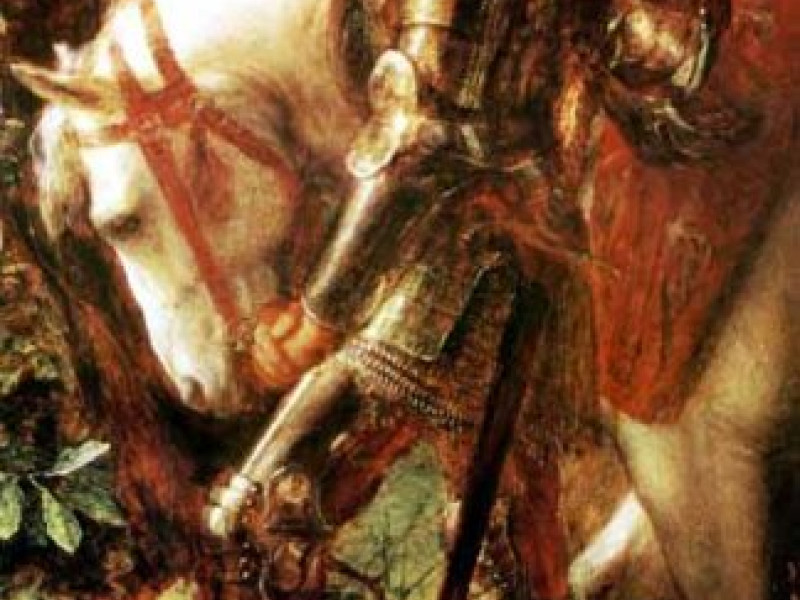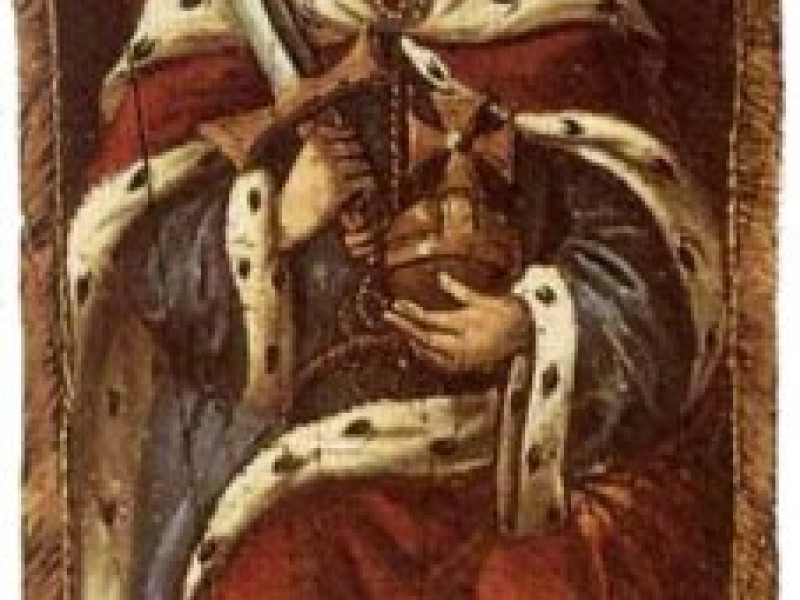Sir Lancelot
Lancelot of the Lake was the most famous knight of the Round Table. Part of his fame was that he became the lover of Queen Guinevere, the wife of King Arthur. Without doubt, Lancelot was the noblest figure in the Arthurian legend.
Lancelot was the son of King Ban of Banoic (or Benoic or Benwick) and Helen or Elaine. (Since there are so many women in Lancelot's life were named Elaine, his mother was usually referred to as Elaine of Banoic or Elaine of Benwick.) His birth/baptismal name was Galahad, but he was always called Lancelot, since his name was revealed in the cemetery of the Dolorous Guard. According to the Grail legend, on his mother's side, Lancelot was the descendant of the noble line of King David of Israel.
Lancelot was not found in Welsh sources, nor other early Arthurian authors – Geoffrey of Monmouth, Wace and Laymon. Lancelot was a character first invented by Chretien de Troyes.
Lancelot's name was first mentioned in Arthurian legend in the Erec and Enide, and appeared briefly when he was defeated in a tournament by the hero of the Cliges, both works of Chretien de Troyes. Both tales don't mention anything about the affairs between Lancelot and Arthur's wife.
However, Lancelot was the hero of Chretien's third work, in the Knight of the Cart. For the first time, Lancelot became the lover of Guinevere. Lancelot had to rescue Guinevere from her abductor named Meleagant.
After Chretien de Troyes, stories of Lancelot's love for Guinevere became the most popular and famous of Arthurian tales. It was heavily influenced by the romance of Tristan and Isolde.
Though Chretien also wrote the first story about the Grail, Lancelot was absent in Le Conte du Graal; the two heroes were Perceval and Gawain. Lancelot's first appearance in the Grail legend was in the anonymous romance titled Le Haut Livre du Graal, or sometimes known as Perlesvaus. In this tale he, along with Perceval and Gawain, were the main characters, though it was Perceval who played the most vital role. See Perlesvaus.
However, in the Vulgate Cycle, Lancelot became the father of a new grail hero who replaced Perceval as the main hero, written almost a half-century after the first Grail's story. Lancelot became the father of Galahad by Elaine, the daughter of King Pelles.
In the Vulgate Cycle, a French collection of the Arthurian tales better known as Lancelot-Graal cycle or Prose Lancelot, Lancelot was the principal character in the first and last work. Though he played a prominent part in the Quest of the Holy Grail (middle tale), he failed to win the Grail because of his love for Guinevere, Arthur's wife. Adultery was considered a mortal sin. This version of the story required the knight to be free of sins, and either chaste or a virgin.
Chretien, who had invented Lancelot, was the first to allude to his birth, saying that he was raised by a lady who was a fairy. However, this fairy was not given a name or title. The lady had given him a magic ring that could break other magic spells. [See Arthurian Romances, p 236, translated by William Kibler, Penguin Classics, 1991]
His father, King Ban, had died of grief when he lost his kingdom to Claudas, king of the Waste Land. Lancelot's mother, Helen (or Elaine), became a nun when her infant son (Lancelot) vanished with Niniane, Vivien or Nimue, better known as the Lady of the Lake.
The Lady of the Lake, who was a fay or faerie from the Otherworld, brought up Lancelot. The Lady of the Lake was named Niniane, Vivien or Nimue. The hero stayed with the Lady of the Lake until he was old enough to become a knight.
Later in the Lancelot (Vulgate Cycle), Lancelot helped Arthur to defeat Claudas. Arthur gave Gaul (France) to Lancelot, including the kingdoms of Banoic and Gaunes, that Claudas had acquired at the death of King Ban and King Bors. When the friendship ended between himself and the two men he loved most (Arthur and Gawain), Lancelot gave the kingdoms of Banoic and Gaunes to his cousins, Bors and Lionel, while he gave the kingdom of Gaul to Arthur.
His earliest adventure after being knighted was when Lancelot became lord of the Dolorous Guard, which he had single-handedly conquered. The Dolorous Guard was renamed to the Joyous Guard after he lifted the curse and enchantment from the castle.
Lancelot also became involved in a war between King Arthur and Galehaut (Galehot). Lancelot befriended Galehaut, the son of a giantess, Lord of the Sorelois and the Distant Isles (Remote Isles). Galehaut's love for his new friend resulted in his willingness to surrender to Arthur at the moment of victory. For this service, Lancelot was offered a place on the Round Table.
It was Galehaut who persuaded Queen Guinevere to return Lancelot's love, and helped his friend to receive his first kiss from the queen. Even though Galehaut wanted Lancelot to come back with him to his kingdom, Lancelot's love for Guinevere took precedence over his friendship with Galehaut. When Galehaut heard false news of Lancelot's death, he fell ill and died. Galehaut was buried with the Joyous Guard (formerly Dolorous Guard).
The next episode of the Vulgate Cycle was similar to the romance told by Chretien de Troyes' Le Chevalier à la charrette ("Knight of the Cart" or "Lancelot"). The knight named Meleagant, son of Baudemagus, abducted the queen; Lancelot sought to rescue the queen by winning one duel against Meleagant, but spared his life. Lancelot was tricked into becoming Meleagant's prisoner. Secretly imprisoned in a remote tower for months, Lancelot was rescued by Meleagant's sister. Lancelot turned up to face Meleagant in a second single combat. This time, Lancelot killed Meleagant by severing his enemy's head.
Elaine, the daughter of King Pelles of Listenois, the Fisher King, tricked Lancelot into sleeping with her. Lancelot thought he was sleeping with Guinevere. The union resulted in the birth of Galahad, the future hero of the Grail quest.
At this stage, Lancelot became the greatest knight in the world. However, during the search for the Holy Grail, Lancelot failed due to his adulterous love for Guinevere, the queen and wife of Arthur. It was his son Galahad who rose to ascendancy and would complete the quest for the grail. (See the Quest of the Holy Grail.)
His affair with Guinevere became one of the most popular romances in Arthurian literature. After the Grail quest, their love set in motion in the destruction of Arthur's kingdom and the dissolution of the fellowship of the Round Table. (See The Death of King Arthur).
Their adultery resulted in the death of Gawain's three brothers, through which Lancelot earned Gawain's enmity, the man whom Lancelot loved above all others. Two disastrous battles between Arthur and Lancelot, would reach their climax with Gawain becoming mortally wounded by his former friend. Their war let Mordred, Arthur's illegitimate son and half-brother of Gawain, commit treason; Mordred crowned himself king of Logres.
When news reached Lancelot of Arthur's death in battle, Lancelot exchanged his armour for a habit, and became a monk. When he died, he was buried beside his friend Galehaut with the Joyous Guard.
In many of the adventures, more than any other knights, Lancelot preferred to win these adventures through various disguises. He was known as the White Knight, the Black Knight and the Red Knight. Other names he was known by are the Injured Knight, the Knight of the Cart, the Knight of the Litter, or the Winner. He used these disguises by changing his armour. Sometimes changing to different shields would achieve the same result, allowing him to go from one adventure to another without anyone recognising him.
At one time, Lancelot let himself be captured by Daguenet, Arthur's Fool, so he was known as Daguenet's Prisoner.
None of his horses, shields or armour had any name attached to them, though his sword was called Secace. Unlike Gawain who had one famous horse all his life, Lancelot often used other people's warhorses. He didn't show the same care for horses as Gawain did; if warranted, he would ride them to death, as he did in Chretien's Chevalier de la Charrete.
The symbol or motif that was most associated with Lancelot was the leopard. I don't recall any heraldic symbol that had a leopard on it (like the emblazon on his surcoat or shield), but there are some visions which indicate that he was the leopard. In the Quest of the Holy Grail (chapter 6) from the Vulgate Cycle, Merlin had apparently foretold that Lancelot's son Galahad would surpass his father, as the lion (Galahad) would surpass the leopard (Lancelot). This comparison between father and son, leopard and lion, could also be found in Thomas Malory's Le Morte d'Arthur (Book 11, chapter 1; Book 14, chapter 2).
Though Arthur and the Round Table gained fame, honour and prestige through the prowess and adventures of Lancelot, Lancelot did it in the name of love. Lancelot's great feat of arms with the Dolorous Guard, killing two giants, and making Galehaut surrender to Arthur - was all done for Guinevere. These early adventures before the quest of the Grail earned him the reputation of being the greatest knight in the world.
Related Information
Name
Lancelot, L'Ancelot (French).
Launcelot (English).
Lancelot du Lac ("Lancelot of the Lake").
Galahad (birth/baptismal name).
King's Son.
Le Chevaler Mal Fet (alias).
Related Articles
King Ban, King Bors, Hector, Sir Bors, Lionel, Niniane, Lady of the Lake, Guinevere, Arthur, Gawain, Galehaut, Morgan le Fay, Merlin.
See also Lancelot of the Lake, Grail, Mort Artu.
Genealogy: House of Lancelot and the Fisher King.
By Jimmy Joe








